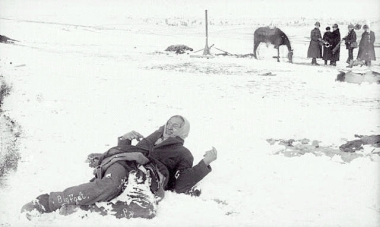
- Details
- By Levi Rickert
Opinion. Editor’s Note: This commentary was originally published by Native News Online in December 2013. It has been updated to reflect 131 years that have passed since the tragic day.
One hundred and thirty-one winters ago, on December 29, 1890, some 150 Lakota men, women and children were massacred by the US 7th Cavalry Regiment near Wounded Knee Creek on the Pine Ridge Indian Reservation. Some estimate the actual number closer to 300.
Snowfall was heavy that December week. The Lakota ancestors killed that day were left in brutal frigid wintry plains of the reservation before a burial party came to bury them in one mass grave. The photograph of Big Foot’s frozen and contorted body is a symbol for all American Indians of what happened to our ancestors.
Some of those who survived were eventually taken to the Episcopal mission in Pine Ridge. Eventually, some of them were able to give an oral history of what happened.
One poignant fact of the massacre has remained in my mind since first reading it. Every time I think about Wounded Knee, I remember this:
"It was the fourth day after Christmas in the Year of our Lord 1890, when the first torn and bleeding bodies were carried into the candlelit church, those who were conscious could see Christmas greenery hanging from the open rafters, across the chancel front above the pulpit was strung a crudely lettered banner: Peace on Earth, Good Will to Men," writes Dee Brown in Bury My Heart at Wounded Knee.
There was no peace on earth for the Lakota four days after Christmas.
Later, as absurd as it may sound, some 20 US Cavalry soldiers were given the Medal of Honor – for killing innocent Lakota men, women and children. What an insult to those who lost their lives. What an insult to humanity.
Rightfully so, there is a movement afoot to strip those soliders of their medals. Hopefully, Congress will see fit to pass the Remove the Stain Act in 2022. They must.
The Wounded Knee Massacre is a symbol for all American Indians of what happened to our ancestors.
History records the Wounded Knee Massacre was the last battle of the American Indian war. Unfortunately, it is when most American history books drop American Indians from history, as well. As if we no longer exist.
Fortunately, American Indians have survived – one generation after another – since Wounded Knee. It is for us who remain to remember our ancestors as we make for a better life for those we encounter today. We are also taught to prepare for the next seven generations, but as we do, we must remember our ancestors.
We remember those ancestors lost 131 winters ago on December 29.
More Stories Like This
Colorado cannot heal until it confronts Sand Creek honestlyNative American Mothers Deserve to Live
Technology Rooted in Tradition is Strengthening Cherokee Nation
The Lumbee Tribe of North Carolina: #575
Tribes Do Not Need a Greenlight to Build Renewable Energy
Help us defend tribal sovereignty.
At Native News Online, our mission is rooted in telling the stories that strengthen sovereignty and uplift Indigenous voices — not just at year’s end, but every single day.
Because of your generosity last year, we were able to keep our reporters on the ground in tribal communities, at national gatherings and in the halls of Congress — covering the issues that matter most to Indian Country: sovereignty, culture, education, health and economic opportunity.
That support sustained us through a tough year in 2025. Now, as we look to the year ahead, we need your help right now to ensure warrior journalism remains strong — reporting that defends tribal sovereignty, amplifies Native truth, and holds power accountable.
 The stakes couldn't be higher. Your support keeps Native voices heard, Native stories told and Native sovereignty defended.
The stakes couldn't be higher. Your support keeps Native voices heard, Native stories told and Native sovereignty defended.
Stand with Warrior Journalism today.
Levi Rickert (Potawatomi), Editor & Publisher

